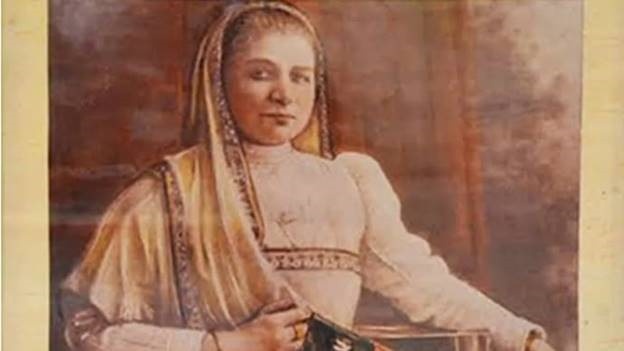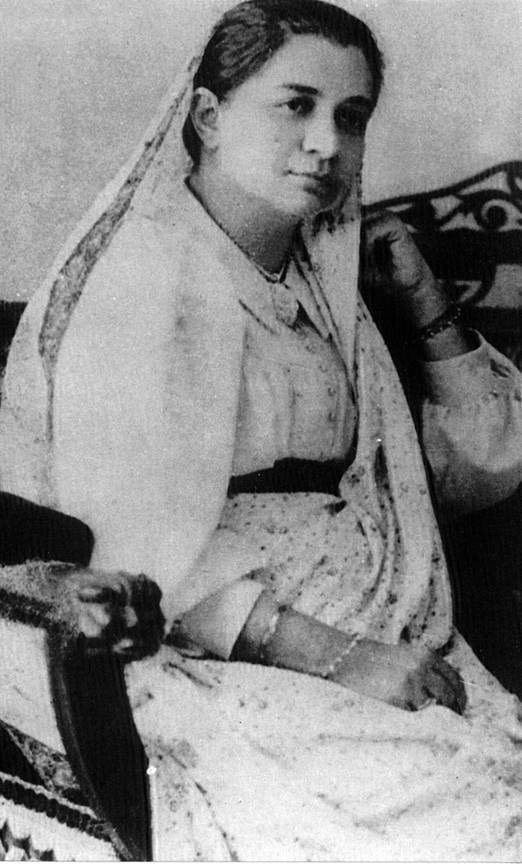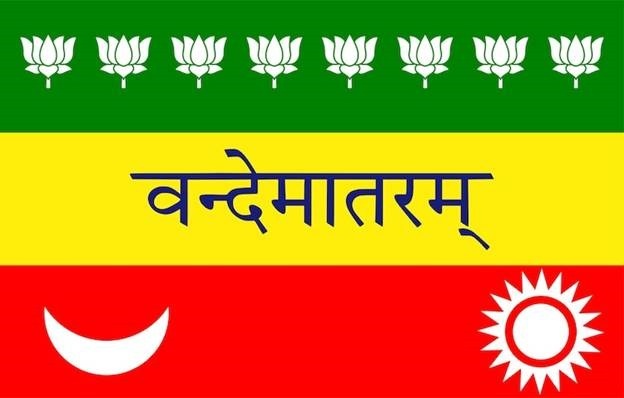Born into privilege, Madam Cama could have enjoyed a life of ease. Instead, she founded the Paris Indian Society to support revolutionaries in exile and became the first Indian to hoist the tricolour flag on foreign soil. It was Bikaji Cama who brought VD Savarkar’s words back to India through his smuggled book, The First War of Indian Independence.
The Berlin Committee Flag, designed by Bhikaiji Cama, Shyamji Krishna Verma, and Vinayak Damodar Savarkar (Image: Wikimedia Commons)
Article by: Rishabh Chauhan | India Today
It was a woman who designed and raised the Indian tricolour for the first time on foreign soil, and a Parsi woman at that. Born in Bombay on September 24, 1861, Bhikaiji Rustom Cama had no idea she was creating history when she made her famed declaration in Germany.
When the Union Jack (the de facto national flag of the United Kingdom) was about to be hoisted as the national flag of India at the International Socialist Conference in Stuttgart, Germany, on August 22, 1907, Madam Bhikaiji Cama boldly opposed it.
Dressed in a traditional Parsi saree, she took out a small tricolour flag from her bag, designed in a small house in Germany, igniting a hush-hush conversation among the attendees.
“Behold! This is the flag of independent India! It has been made sacred by the blood of young Indians who sacrificed their lives,” Madam Cama declared, unfazed.
Her courageous act astounded all the dignitaries present at the event and made her a notable figure. Her words resonated deeply with those present, and many delegates stood to salute this powerful symbol of resistance against colonial oppression.
This act was not just about raising a flag; It was a public declaration of India’s desire for autonomy and an appeal to the international community for support against British oppression.
Cama’s statement on an international platform brought significant attention to India’s struggle for independence at a time when many were unaware of the dire conditions under British rule.
Her passionate speech highlighted the devastating effects of British colonialism on India, including famine and economic exploitation.
Cama’s actions were indeed risky. At that time, any form of dissent against British rule could lead to severe consequences. Nevertheless, she remained undeterred, believing that raising awareness about India’s plight was crucial to garnering support for independence.
Little did she know that her bold move would become a symbol of India’s independence, and would be remembered even 86 years after her death.
HOW THIS PARSI WOMAN BECAME A REVOLUTIONARY
Born in 1861 to affluent Parsi trader Sorabji Framji Patel, Madame Cama completed her education at the Alexandra Girls’ Education Institute.
She married Rustomji Cama at the age of 24, but from the beginning, the couple had very distinct political views, which became a source of strife between them. Rustomji Cama, a lawyer, admired the British while also cherishing his culture.
In contrast, Bhikaiji saw the ruthless exploitation of Indians by the British, which fuelled her resolve to challenge their rule.
(Image: Wikimedia Commons)
“At the time of independence, India will not only be freed, but women will also receive all their rights,” was her stance. Cama believed that the long suppression of women would end once the British left the country.
She spent a considerable part of her life in exile, mainly living abroad, yet she utilised this time to journey across Europe and America to gather resources and support for her organisation, the Parsi Indian Society. This nationalist group served as a refuge for Indian revolutionaries escaping from England.
The bubonic plague outbreak in 1896 in Gujarat revealed the true spirit of Bhikaiji Cama. She dedicated herself to humanitarian efforts, donning a plain white apron and renouncing the luxuries she had once enjoyed while serving those in need.
While caring for patients during a severe outbreak, Bhikaiji Cama contracted the deadly bubonic plague herself and subsequently left India in 1902 to seek further medical treatment in London.
Even after relocating to London, Cama kept the revolutionary spirit alive. There, she was fortunate to encounter fellow revolutionaries like Savarkar and Senapati Bapat, who shared her determination to fight against British rule. Together, they created a hub for Indian revolutionaries living abroad.
Shyamji Krishna Verma, a nationalist known for his impassioned speeches in Hyde Park, established the India House in London in 1905 to further this cause.
HOW INDIA’S FIRST FLAG WAS DESIGNED
The Berlin Committee Flag, designed by Bhikaiji Cama and Shyamji Krishna Verma emerged in the early 20th century as a powerful symbol of India’s struggle for independence from British rule. Vinayak Damodar Savarkar is also believed to have worked on it.
Formed in 1905 by Shyamji Krishna Verma, the Berlin Committee aimed to promote Indian nationalism and support revolutionary activities against British rule. The flag was one of the symbols of this movement.
Crafted in the context of rising nationalism, this flag which was hoisted by Cama in Germany, featured three horizontal stripes — saffron at the top, representing courage and the Hindus; green in the middle, symbolising faith and the Muslim community; and red at the bottom, denoting bravery and the rest of India.
India’s flag designed by Bhikaiji Cama, VD Savarkar and Shyamji Verma (Image: X)
The design included eight blooming lotuses on the green stripe to signify India’s eight provinces at the time, while ‘Vande Mataram’ was inscribed across the saffron middle stripe. The bottom red stripe showcased a half moon on one side and a rising sun on the other, reflecting the unity of Hindus and Muslims in the fight for independence.
This bold display was not just a challenge to British authority; it aimed to unite Indians abroad and inspire those back home.
The Berlin Committee Flag holds significant historical importance as a precursor to the tricolour adopted by India in 1947.
HOW CAMA BROUGHT SAVARKAR’S WORDS TO INDIA
When the British government banned Vinayak Damodar Savarkar’s book, The First War of Indian Independence 1909, Cama took it upon herself to smuggle copies into India, ensuring that people could access this vital information and know about the revolutionary stories of Indian fighters against oppression.
She even translated the book into French. The text, cleverly concealed in wrappers of other literary works, was eventually published in the Netherlands in 1909, becoming a pivotal resource for Indian revolutionaries. It highlighted the events of the 1857 Sepoy Mutiny and showcased prominent figures, inspiring a new generation of youth in India.
BHIKAIJI CAMA’S LEGACY
Cama played a crucial role in keeping the flame of India’s freedom struggle alive on foreign soil. Her influence extended to the international community, where she worked tirelessly to pressure European governments to support India’s quest for independence.
After her historic act, Cama continued her activism by travelling extensively to raise awareness about India’s plight. She fought for women’s rights and emphasised their crucial role in nation-building.
The British authorities once warned Bhikaiji Cama that her involvement in revolutionary activities could lead to her permanent exile from India. Following the assassination of Sir William Hutt Curzon Wyllie by Madan Lal Dhingra in 1909, just two years after Cama’s bold move into Germany, the British government targeted several Indian activists, including Cama.
They confiscated her assets in India and sought her extradition from France. However, Madam Cama remained unyielding, continuing her resistance with remarkable courage.
Interestingly, a woman not only eager to voice her beliefs but also determined to enact change, Cama played a pivotal role in formulating Savarkar’s escape plan following his arrest in London. During his trial, she launched a movement in France advocating for his release.
Her courage remained steadfast even after Savarkar was sentenced to life imprisonment, and she continued her efforts to free her nation despite facing fierce opposition from the British.
After nearly 33 years of exile, Cama was finally granted permission to return to India. Upon her arrival in Mumbai, she passed away just nine months later, in 1936. In her will, she generously decided to donate most of her assets to the Avabai Petit Trust, supporting orphaned girls in need.
Bjikaji Cama’s contributions to India’s independence movement were profound and far-reaching. As a passionate advocate for Indian nationalism, she worked tirelessly to rally support for India’s cause beyond its borders.
Living in Europe, she connected with Indian expatriates and sought allies in the international community, particularly among those who opposed colonialism.
Her contributions have often been overshadowed in history, but Madam Bhikaiji Cama remains an enduring symbol of courage and dedication to India’s freedom struggle. The flag she designed not only represented a nation’s aspirations but also highlighted her belief that unity among all Indians was essential for achieving independence.



